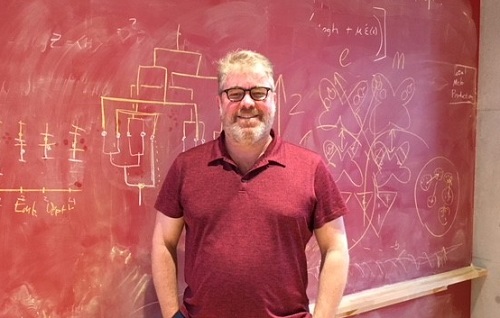
Making changes: John Hernlund.
By Michael Banks in Tokyo, Japan
Following this morning’s talk at the Tokyo Institute of Technology (as well as a mock earthquake evacuation drill that took place just afterwards), I took the opportunity to visit the Earth-Life Science Institute (ELSI), which is located in a neighbouring building at Tokyo Tech.
Like the Kavli Institute for the Physics and Mathematics of the Universe (IPMU), which I visited yesterday, ELSI is part of the World Premier International Research Center Initiative (WPI).
ELSI began in 2012 and has funding for 10 years from the WPI. There are around 100 people working there, the majority of whom are from outside Japan. Its main aim is to understand how life began on Earth and how that can be applied to the search for life on other planets. It covers a range of disciplines from astrophysics to microbiology.
I sat down with John Hernlund, ELSI’s vice director, and Shawn McGlynn, a principal investigator at the institute. Both are from the US, and Hernlund joined in 2013, becoming the first permanent foreign researcher to work at Tokyo Tech.
Hernlund, who works in astrobiology, notes that one of the fun aspects of working at the institute – apart from the science – is changing how things are done. For example, when the institute was founded it went on a big recruitment drive by placing advertisements in the media. But Hernlund and colleagues quickly discovered that there was no process at the university to do this – it wasn’t how universities in Japan traditionally brought people in.
This resulted in staff members dipping into their own pockets to pay for the advertisements. They eventually got reimbursed, but it took nearly a year to sort it all out and put in place a system should anyone at the university want to follow suit. “This is why reform is so important,” says Hernlund, adding that he hopes such changes will “propagate outside ELSI”.
Given the institute’s funding is guaranteed for only another five years, ELSI is now trying to diversify its income to guarantee its future. Hernlund notes the temptation to even turn away from the WPI programme itself to help the institute become self-sustaining and have more flexibility than it would do if it stayed in the system. One avenue being explored to do this is attracting more private funding.
After visiting ELSI and IPMU it is apparent that these two institutes feel very different from a traditional Japanese physics department. Bringing in foreign researchers – a mandate of the WPI programme – is certainly shaking up the academic system in Japan. It will be interesting to see how much further those reforms go.
Guidelines
Show/hide formatting guidelines
this text was deletedwhere people live in harmony with nature and animals</q>
Some text